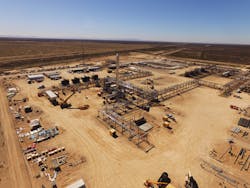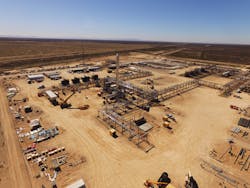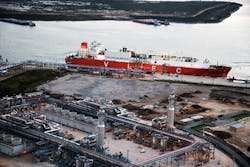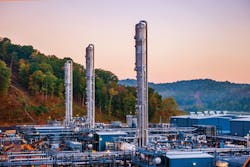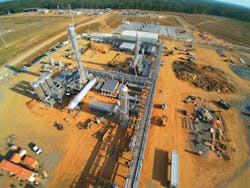Regional, market changes influence US onshore gas processing work
Matt Zborowski
Assistant Editor
The gas processing space was in the midst of a regional and structural shift when OGJ published its final worldwide gas processing survey in June 2015. The piece captured the upward trend in US onshore plant capacity during the height of the shale boom of 2011-14, which accounted for much of the global capacity movement during that time.
Despite commodity prices gradually sinking to lows not anticipated by the industry, existing projects reached completion stages into 2014-15, but newer projects weren't sanctioned. More cautious midstream operators are now taking a wait-and-see approach when it comes to advancing new plants, and those that do elect to build are urging contractors to squeeze out efficiencies to cope with constrained budgets. "Capacity additions have slowed by nearly half, but the number is still impressive," Prachi Mehta, Wood Mackenzie Ltd. research analyst, NGLs, told OGJ. "I would say the biggest change in gas processing is the shift in basin focus," she said, noting that the "Permian dominates capacity additions since the price downturn."
In the past, the Appalachian region's Marcellus and Utica shales and the Eagle Ford shale of South Texas "were touted to lead NGL production growth," Mehta explained. "The Appalachia gas boom came with wet gas that needed processing, but Appalachia midstream infrastructure was minimal. Hence, we saw a wave of processing plants in the Northeast in 2014-15. After the crude oil collapse, producers shifted attention to the Permian-specifically the Delaware basin-with its promise to provide the best rate of return at low prices," she said, adding, "While the Permian did have legacy processing, a lot of the new activity was focused on the southern Delaware while legacy plants were in the northern Delaware-most of them in New Mexico."
Ajey Chandra, managing director of the Houston office of consulting firm Muse, Stancil & Co. and leader of its midstream practice, said he's been receiving lots calls from clients about the Permian given the growing volumes of gas produced in the region. "There's been a lot of new plants announced in the Permian. There's a fair amount of [merger and acquisition activity] going on in the Permian, and with most of the M&A, the companies that are being bought have plans to continue to build more plants. And I think we're attracting a fair amount of private equity money into the industry because they're attracted to that backlog" of additional projects, he said.
Private equity is the primary source of capital in the Permian at the moment as companies attempt to move past the downturn, Chandra said. "You've got the midstream guys who don't have a lot of money, and if they've got to put a lot of money on the ground, they've got to go out and get it. You've got the integrated producers who are trying to do some midstream activity themselves, and a fair number of them-as they've gotten stressed-would rather put their money into drilling wells and let somebody else put up the capital for pipelines and plants."
In February, Dallas-based Matador Resources Co. and Houston private equity firm Five Point Capital Partners LLC formed San Mateo Midstream LLC to operate and expand Matador's midstream assets in the Delaware basin in Eddy County, NM, and Loving County, Tex. San Mateo plans to expand its Black River cryogenic processing plant capacity in the Rustler Breaks area of Eddy County to as much as 260 MMcfd of gas. It's expected to be operational as early as first-quarter 2018. Matador received $171.5 million in connection with the combine's formation and may earn up to an additional $73.5 million in deferred performance incentives over the next 5 years. Among deals solely in the private equity space, Blackstone Energy Partners and Blackstone Capital Partners last month agreed to acquire EagleClaw Midstream Ventures from its financial sponsor EnCap Flatrock Midstream for $2 billion.
Michael Tecza, McKinsey & Co. vice-president, major projects, and former director of program and construction management at The Shaw Group, nonetheless noted that Appalachia midstream activity at the moment is elevated. "When you go out onto these various spreads and the compressor stations, the manual workforce that's in these areas now is extremely high. You literally have these overnight man camps of welders and pipefitters and technicians setting up and moving with these various trunklines. [It's] something that I haven't seen in years."
Along with private equity, Tecza said the "big players," or companies with a market cap of $100-300 billion, are moving into the Permian. In Appalachia, the "old-time players," or companies with a market cap of $12-40 billion, are still most active. Those old-time players are either being acquired through M&A, or they're building trunklines to move the gas south. "The midstream companies are scrambling right now to make sure they can get this gas out of the Marcellus and Utica and into the Gulf Coast," he said.
Appalachian gas primarily serves electric power distribution along the East Coast, though the 5.25 million-tonne/year Dominion Cove Point LNG export facility on Chesapeake Bay in Lusby, Md., is expected to be operating late this year, and Sunoco Logistics Partners LP's Marcus Hook industrial complex near Philadelphia opened up a new market for Appalachia NGL producers in 2016. Permian gas currently benefits from a broader market that includes power as well as a growing number of crackers, fractionators, and LNG and NGL export facilities.
Chandra added, "Another surprising thing is the whole LNG export route and how that's changing all of midstream because so much of the midstream stuff that's being built now is around the pipelines that are oriented toward taking additional gas from the Permian basin, additional gas from Oklahoma, and bringing it down to the Gulf Coast toward the LNG facilities-whether that be Corpus [Christi] or Sabine [Pass] or the Houston Ship Channel area."
New NGL opportunities
An abundant and convenient supply of NGLs from expanded gas production has resulted in a buildout of NGL export facilities and petrochemical projects on the Gulf Coast and to a lesser extent, with the Cove Point and Marcus Hook facilities, on the East Coast. "Generally speaking, the value of NGLs is on the rise and the spread to gas has been increasing marginally," Mehta explained. "This improvement has largely come on the back of the ability of US LPG to reach global markets and partly because of increased ethane demand from exports. Ethane would play a bigger role in the future as eight new steam crackers start operations on the US Gulf Coast over the next 3 years. These crackers will almost exclusively take ethane," which "will certainly" help boost ethane prices and lift NGL value relative to gas, she said.
The US is the global leader in LPG exports with the Gulf Coast serving as the primary supply hub, a big change from 5 years ago when the country was a net importer of propane and butane. Analytics firm RBN Energy notes that roughly half of all LPG from US gas processing plants was exported during 2016. Leading the way is Enterprise Products Partners LP's (EPP) 27,500 bbl/hr LPG export terminal on the Houston Ship Channel. It averaged loading volumes of 420,000 b/d in 2016, up from 299,000 b/d in 2015 and 248,000 b/d in 2014.
Another active propane and butane shipping hub is Sunoco Logistics' Nederland, Tex., terminal, which provides 1 million bbl of storage and distribution services for NGLs in connection with the 200,000-b/d Mariner South pipeline project. The pipeline is part of a joint project with a subsidiary of Energy Transfer Partners LP (ETP) to deliver export-grade propane and butane products from the Mont Belvieu, Tex., storage and fractionation hub to the Nederland marine terminal.
In the Northeast, Evergas' JS Ineos Intrepid in March 2016 exported Marcus Hook's first 27,500-cu m shipment of ethane to Rafnes, Norway, representing the first overseas export of Marcellus-produced ethane. LPG exports have ramped up from the terminal over the past year as well, averaging 40,000 b/d each month between October 2016 and this past March, according to RBN Energy data. The Marcus Hook complex serves as an offtake outlet for Sunoco's Mariner East 1 system, part of the Mariner East project that moves NGLs from the Marcellus and Utica areas in western Pennsylvania, West Virginia, and eastern Ohio. Mariner East 2, expected to begin operations in this year's first half, will expand total takeaway capacity to 345,000 b/d for interstate and intrastate ethane, propane, and butane service.
Six months after the JS Ineos Intrepid made its historic voyage from Marcus Hook, the LNG multigas carrier, again destined for Rafnes, transported the first ethane export shipment from EPP's Morgan's Point terminal on the Houston Ship Channel. The terminal has an aggregate loading rate of 10,000 bbl/hr of fully refrigerated ethane, and supply is sourced from EPP's Mont Belvieu NGL fractionation and storage complex through an 18-mile, 24-in. OD pipeline completed in February 2016.
Mehta also noted that "the development of demand market increases NGL uplift, which influences marginal decisions of drilling in wet or dry gas plays," including in the Northeast. She cited as an example the combine announced in February between Antero Midstream Partners LP, which supports production from Antero Resources Corp., and MPLX LP subsidiary MarkWest Energy Partners LP to build three processing trains totaling 600 MMcfd at the Sherwood complex of West Virginia during 2017-18. The venture expects to begin operations at two of the facilities during this year's first and third quarters and at the third plant during first-quarter 2018. Also under consideration is development of up to eight more processing facilities that would be at both the Sherwood complex and a new location in West Virginia. "Antero's liquid focus is based on its positive outlook for NGLs, both due to NGL export facility expansion at Marcus Hook and increased demand from Gulf Coast projects," Mehta explained.
Antero's NGL production also will be supported by three fractionation units providing 180,000 b/d of propane-plus fractionation capacity at the Hopedale complex in Ohio's Harrison County. The group is investing in 20,000 b/d of existing fractionation capacity at the Hopedale complex and has an option to invest in future fractionation expansions at the complex subject to the production of incremental NGLs from the venture's processing facilities.
Alongside processing capacity additions in the Permian, NGL pipeline takeaway connecting the Permian with the Mont Belvieu fractionation hub has grown, Mehta noted. ETP in April 2016 brought online the Lone Star Express pipeline that can move as much as 375,000 b/d of NGLs from the Permian to Mont Belvieu. In January, DCP Midstream LP announced it's expanding its Sand Hills pipeline by 30% to 365,000 b/d before yearend. In April, EPP announced the construction of the Shin Oak NGL pipeline to carry 250,000 b/d of raw mix from the Permian to Mont Belvieu.
EPP plans to expand its Mont Belvieu fractionation complex by 85,000 b/d with a ninth fractionator that's expected to be in service second-quarter 2018. ETP announced in February that its fifth Mont Belvieu fractionator, which will have a capacity of 120,000 b/d, will be operational September 2018.
Harnessing efficiencies
Within the Permian, local processing complexes serve each of the Midland basin, Texas portion of the Delaware basin, and New Mexico portion of the Delaware basin, Mehta explained. "Technically, a company could connect its Delaware and Midland processing to optimize utilization of all its plants before constructing new ones," she said. "Because the Permian is geographically spread out, it becomes a question of efficiency vs. cost. Is it cheaper to connect your plants by a pipeline or just construct a new plant closer to production? While companies are constructing new plants, some of them are considering or moving ahead with more integration across assets," she said, adding, "For instance, Targa Resources Corp. is going to connect its newly acquired Delaware plants within its existing Delaware system and also connect its West Texas (Midland) system. Ultimately, [Targa] wants to create a 'fully-connected Permian system.'"
As for plant construction, Mehta said more companies are offering modular units, but a majority of construction remains on-site. She also mentioned the availability of options for portable gas processing targeted at smaller, remote sites. Pioneer Energy, for example, offers a skid-mounted, modular, integrated processing plant designed to meet the varying requirements of each project it serves. The 20-MMscfd plant produces as much as 80,000 gpd of NGLs and 100,000 gpd of diesel fuel replacement gas. Anne Keller, WoodMac research director, NGLs, noted modularization "seems to increasingly be a thing" in the US, "although there are some issues around long-term maintainability and reliability associated with modular construction that don't seem to be as important in a world where hard assets are treated like stocks and bonds."
Jeff Reilly, president of business development for Amec Foster Wheeler PLC, has observed modularization is "being used a heck of a lot more in this midstream space in the US than traditional stick-built. Part of it was a little less bespoke [specifications] like there were in other parts of the onshore business and part of it was just the rapid nature of an infrastructure that needed to get built out in the US with all the shale oil and gas that needed to get to markets." More so than modularization, Reilly said, the conversation has revolved around general capital efficiency because of lower oil and gas prices. "How do you economically get that asset out of the ground at a lower price?" That could mean "modularization where it makes sense, copying designs, not having bespoke designs for everything, and not having everything absolutely fit for purpose," he said.
Keller said the typical plant train in the US "is now either 200 MMcfd or 300 MMcfd, ordered from TH Russell-Honeywell, and mostly modular in terms of the design of the key components." According to the company's web site, UOP Russell's line of modular plants claims a "6-months faster speed to first gas for many projects than competitive offerings." Keller continued, "If the train is a bolt-on addition at an existing site, there's no need for lead time to bring in utilities and set up the site, so the lead time is permitting, which was 18-24 months and now is probably more like 9-12. If it's greenfield, like the [EPP] plants at Orla, [Tex.,] it's still 18-24 months from permitting to operation.
"The construction challenges are largely the issues involved in hiring, mobilizing, and housing a workforce in remote locations that basically has to camp out for the duration of the project since there is very little in the way of civilization around some of these sites," Keller explained. "Specialized craft labor such as [instrumentation and electrical] techs, specialized welders, and so on wouldn't be able to commute and work a 12-hr day.
"Gas plant construction cost rules of thumb have gone down from $1/Mcf of capacity-[such as] $300 million for a 300 MMcfd plant-to as low as 50¢/Mcf now on an existing site. There isn't a huge rate of return anymore on building just processing plants since there are so many companies trying to do it. The integrated midstream companies can offer service packages that include processing and takeaway for the marketable products that allow them to tailor the terms of a deal to appeal to the people who make the decisions, and these days processing is heading toward more of a breakeven proposition to gain control of the gas and liquid volumes.
"A lot of folks need to be thinking about how the rise of the integrated midstream company will change the nature of the business. For instance, both [EPP] and [ETP] can now offer services to move gas, NGLs, and crude oil all the way from the plant or field to the export markets, including loading for everything other than natural gas," Keller said. "It's not just about NGLs anymore."
